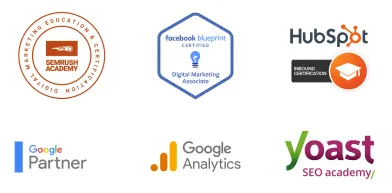TO LEARN IS TO GROW
Learning Center
We do our research and publish our results. Should probably call this the Growing Center.


Quick Reference to Marketing Automation
We created a quick reference to marketing automation in which repetitive, tedious tasks such as email marketing, ad campaigns, and social media posting are streamlined and measured.
Marketing automation refers to software and technologies that automate repetitive marketing activities such as social media posting, email marketing, ad campaigns, etc. Contrary to popular belief, they are used not just for efficiency but also to create a more personalized buyer’s experience.
In a nutshell, the ultimate goal of market automation is to generate more revenue by driving traffic to your website and converting leads into actual customers without you having to spend too much “resources” like time and talent.
Instead of wasting time on repetitive and tedious tasks, your staff can focus more on the most important thing–growing your business. Customer relationship management or CRM.
Most Common Types of Automation
Marketing automation comes in several software programs that perform different internal and external marketing activities. Meanwhile, below is the list of the most common types of automation that can benefit any kind of business, regardless of its size and industry.
Customer relationship management or CRM
CRM is one of the most widely used marketing automation programs in recent years because of the growing demand for a personalized buyer’s experience.
An excellent CRM aggregates customer data such as demographics, email addresses, location, and contact information in one convenient space. This allows sales and marketing departments to communicate with existing and potential customers in a way that reflects where they are at in the buyer’s journey.
By meeting where the people are, brands enjoy higher conversion rates and lower marketing costs because they only concentrate on targeting the right people.

Email marketing automation

Email marketing is around 40 times more effective than social media platforms, according to a study conducted by McKinsey & Company. However, this is a time-consuming, tedious campaign unless you do it with the help of software automation.
A good email marketing program facilitates the large-scale distribution of personalized content and comes with analytics and performance measurement dashboards to improve or tweak your campaigns.
Ideally, your email software should also come with a wide selection of email templates and editing tools, allowing you to create professional-looking content even with no or very limited design knowledge.
When using this automation tool, it is ideal to combine email blasts (like newsletters to announce new products/promos and greet subscribers during holidays) and trigger-based emails (such as the welcome message received by someone who just signed up to your email list).
Social media automation
Social media management is a great way to reach your target audience, although it is a time-consuming and tedious process that deters many small businesses.
Fortunately, automation programs can free up your time so you (or your staff) can focus more on generating catchy, customer-centric content.
A good automation software publishes and schedules content, tracks results (including the number of website visitors that found you via your social media account), and identifies and learns about your audience across all social platforms.
It is also nice to have a program that manages your messenger apps by providing canned responses to general customer inquiries.
Marketing and sales workflow software

This automation software manages your day-to-date content, drives traffic to your website, creates landing pages, and sets up marketing campaigns.
HubSpot’s marketing and sales workflow automation is one of the most popular software because of its customizable workflow that maps out the buyer’s journey.
While this automation software streamlines many tedious tasks, it often comes with a high price tag.
Blog automation software
First things first: this software does not generate content for you, although it can eliminate the tedious task involved in managing and building a blog, making this ideal if you are pressed for time and you lack coding skills.
This automation software also allows you to customize your blog (by adding CTAs, images, texts, etc.), use pre-designed blog templates, and sync your post with your email marketing campaigns.
With blog automation software, you can publish, schedule, and share your blog posts across your social media accounts.
To make sure that you create content that resonates with your audience, you need to use the built-in analytics that will tell you how well your posts perform.
Webform automation
This is quite similar to the landing page builder, although it comes with additional features such as data collection that allows you to access information about your audience; this enables you to improve your marketing campaigns, services, and products.
How Does Marketing Automation Help Business?
Contrary to popular belief, marketing automation is not just reserved for large businesses and well-known brands. In fact, it provides unique benefits to small businesses, solo entrepreneurs, and side hustlers who have limited time, talent, and resources to do all tasks “manually.”
Remember that automating some aspects of marketing and sales allows you to focus on the overall business strategy and improve your services and products.
Additionally, the right automation tools provide a more detailed picture of your target customers’ [online] behavior.
Data analysis is another reason why marketing automation is crucial to your brand, allowing you to tweak your campaign and content in a way that resonates with your audience, which in turn results in revenue growth and better customer retention.
To learn more about marketing software and automation, contact LOJO Marketing at (916) 303-4080 or click here to schedule a free evaluation and consultation with our chief inbound marketing specialist Stephen.
Built for Growth. Backed by 25 Years of Trust.
For over two decades, LOJO has been a trusted partner to hundreds of businesses just like yours. Whether working directly with owners, managers, teams, or boards of directors, our goal remains the same: to be a reliable and results-driven asset to your business.
Over the years, we’ve carefully built a team of experts—each selected for their unique skills, strengths, and personalities. Our clients choose LOJO because they know we genuinely care about their success.
And after 25 years of helping businesses grow, we’re more committed than ever.



Built for Growth. Backed by 25 Years of Trust.
For over two decades, LOJO has been a trusted partner to hundreds of businesses just like yours. Whether working directly with owners, managers, teams, or boards of directors, our goal remains the same: to be a reliable and results-driven asset to your business.
Over the years, we’ve carefully built a team of experts—each selected for their unique skills, strengths, and personalities. Our clients choose LOJO because they know we genuinely care about their success.
And after 25 years of helping businesses grow, we’re more committed than ever.




Matthew Rogers, President
iProspect Check
After spending several months reviewing multiple proposals from several different companies we engaged LOJO to develop a new website that represents our company effectively. We worked initially with Stephen Platte who helped create the scope of the project. Stephen was knowledgeable and always followed up with me on time and as promised.
He "closed the deal" for LOJO with his professionalism, service orientation and easy going approach. Once we signed the contract we were introduced to Jay Kelly who would be the creative lead for LOJO. This was the most challenging part of the project for my company, as there was no shortage of ideas from our side. Jay managed the project flawlessly, and once we had all agreed to the design, Jay introduced us to Eric.
Eric Lay is one of the founders of LOJO. Eric took the design we had developed and brought it to life. We delivered content as quickly as he requested it. Eric kept the project on task and we responded by exceeding every deadline for content. In turn, once provided, literally not a day went by that Eric didn't add the content and take the next step. In just a few weeks we launched our new website. Eric is a pleasure to work with.
His positive attitude and consultative approach really enhanced the experience and made a big difference for us in the outcome of our project. We would welcome you to visit our website to take a look at the quality work of LOJO. We are very pleased with LOJO and look forward to working with them in the future as we pursue an aggressive SEO strategy."
After spending several months reviewing multiple proposals from several different companies we engaged LOJO to develop a new website that represents our company effectively. We worked initially with Stephen Platte who helped create the scope of the project. Stephen was knowledgeable and always followed up with me on time and as promised.
He "closed the deal" for LOJO with his professionalism, service orientation and easy going approach. Once we signed the contract we were introduced to Jay Kelly who would be the creative lead for LOJO. This was the most challenging part of the project for my company, as there was no shortage of ideas from our side. Jay managed the project flawlessly, and once we had all agreed to the design, Jay introduced us to Eric.
Eric Lay is one of the founders of LOJO. Eric took the design we had developed and brought it to life. We delivered content as quickly as he requested it. Eric kept the project on task and we responded by exceeding every deadline for content. In turn, once provided, literally not a day went by that Eric didn't add the content and take the next step. In just a few weeks we launched our new website. Eric is a pleasure to work with.
His positive attitude and consultative approach really enhanced the experience and made a big difference for us in the outcome of our project. We would welcome you to visit our website to take a look at the quality work of LOJO. We are very pleased with LOJO and look forward to working with them in the future as we pursue an aggressive SEO strategy."

Matthew Rogers, President
iProspect Check
The team at LOJO were wonderful to work with. They are well organized and very patient as we worked through our marketing strategy and developed a well thought out and clear action plan at a reasonable price. We will definitely be back for our future campaign needs."

Jon Crosby, Founder
Dazil

